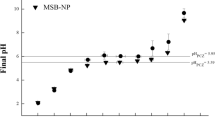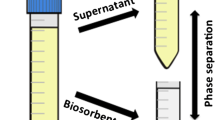Abstract
In the present study, two agro-industrial wastes, sugarcane bagasse, and peanut shell were employed as support of magnetite nanoparticles for the synthesis of magnetic bio-composites: magnetic sugarcane bagasse (MBO) and magnetic peanut shell (MPSo). The presence of magnetite was verified by Raman spectroscopy. Magnetic nanoparticles shape and size distribution were studied by TEM, while composites morphologies were observed by SEM. Structural characteristics of the pesticides and their possible chemical adsorption on composites were analyzed by FTIR. The removal was carried out by a batch adsorption process, and UV-VIS technique was used for pesticide concentration estimation. Elovich model described better all systems pointing out to a chemical adsorption process occurring. Experimental data isotherms of carbofuran and iprodione can be best explained by more than one mathematical model, but Sip was the ordinary equation in all systems. Maximum adsorption capacities of 175 and 89.3 mg/g for carbofuran, and 119 and 2.76 mg/g for iprodione, were obtained for MBo and MPSo, respectively.









Similar content being viewed by others
References
Agarwal UP, Reiner RR, Ralph SA (2013) Estimation of cellulose crystallinity of lignocelluloses using near-IR FT-Raman spectroscopy and comparison of the Raman and Segal-WAXS methods. J Agr Food Chem 61:103–113
Akl MA, Youssef AFM, Hassan AH, Maher H (2016) Synthesis, characterization and evaluation of peanut shells-derived activated carbons for removal of methomyl from aqueous solutions. J Environ Anal Toxicol 6:2–11
Aktar W, Sengupta D, Chowdhury A (2009) Impact of pesticides use in agriculture: their benefits and hazards. Interdiscip Toxicol 2:1–12
Ali RM, Hamad HA, Hussein MM, Malash GF (2016) Potential of using green adsorbent of heavy metal removal from aqueous solutions: adsorption kinetics, isotherm, thermodynamic, mechanism and economic analysis. Ecol Eng 91:317–332
Amrhar O, Nassali H, Elyoubi MS (2015) Application of nonlinear regression analysis to select the optimum absorption isotherm for methylene blue adsorption onto natural illitic clay. Bull Soc Roy Sci Liège 84:116–130
Armenta S, Garrigues S, De La Guardia M (2007) Determination of iprodione in agrochemicals by infrared and Raman spectrometry. Anal Bioanal Chem 387:2887–2894
Barathi M, Kumar AK, Kumar CU, Rajesh N (2014) Graphene oxide–aluminium oxyhydroxide interaction and its application for the effective adsorption of fluoride. RSC Adv 4:53711–53721
Behloul M, Lounici H, Abdi N, Drouiche N, Mameri N (2017) Adsorption study of metribuzin pesticide on fungus Pleurotus mutilus. Int Biodeterior Biodegradation 119:687–695
Bitar M, Maalouly J, Chebib H, Lerbret A, Cayot P, Bou-Maroun E (2015) Experimental design approach in the synthesis of molecularly imprinted polymers specific for iprodione fungicide. React Funct Polym 94:17–24
Bobik M, Korus I, Dudek L (2017) The effect of magnetite nanoparticles synthesis conditions on their ability to separate heavy metal ions. Arch Environ Prot 43:3–9
Bouabidi ZB, El-Naas MH, Cortes D, McKay G (2018) Steel-making dust as a potential adsorbent for the removal of lead (II) from an aqueous solution. Chem Eng J 334:837–844
Brandão PC, Souza TC, Ferreira CA, Hori CE, Romanielo LL (2010) Removal of petroleum hydrocarbons from aqueous solution using sugarcane bagasse as adsorbent. J Hazard Mater 175:1106–1112
Cardona CA, Quintero JA, Paz IC (2010) Production of bioethanol from sugarcane bagasse: status and perspectives. Bioresour Technol 101:4754–4766
Chang KL, Lin JH, Chen ST (2011) Adsorption studies on the removal of pesticides (Carbofuran) using activated carbon from rice straw agricultural waste. Int J Biolo Biom Agric Food Biotech E 5:210–213
Chaukura N, Gwenzi W, Tavengwa N, Manyuchi MM (2016) Biosorbents for the removal of synthetic organics and emerging pollutants: opportunities and challenges for developing countries. Environ Dev 19:84–89
Chen JQ, Hu ZJ, Ji R (2012) Removal of carbofuran from aqueous solution by orange peel. Desalin Water Treat 49:106–114
Congcong D, Cheng W, Sun Y, Wang X (2015) Novel fungus Fe3O4 bio-nanocomposites as high performance adsorbents for the removal of radionuclides. J Hazard Mater 295:127–137
Davis JP, Dean LL (2016) Peanut composition, flavor and nutrition. In: Stalker HT, Wilson RF (eds) Peanuts genetics, processing, and utilization. Elsevier, pp 289–345
de Paiva FFG, de Maria VPK, Torres GB, Dognani G, dos Santos RJ, Cabrera FC, Job AE (2019) Sugarcane bagasse fiber as semi-reinforcement filler in natural rubber composite sandals. J Mater Cycles Waste Manage 21:326–335
El-Reash YA, Abdelghany AM, Elrazak A (2016) Removal and separation of Cu (II) from aqueous solutions using nano-silver chitosan/polyacrylamide membranes. Inter J Biol Macromolecules 86:789–798
Garbin JR, Milori DMB, Simões ML, da Silva WT, Neto LM (2007) Influence of humic substances on the photolysis of aqueous pesticide residues. Chemosphere 66:1692–1698
Georgin J, Dotto GL, Mazutti MA, Foletto EL (2016) Preparation of activated carbon from peanut shell by conventional pyrolysis and microwave irradiation-pyrolysis to remove organic dyes from aqueous solutions. J Environ Chem Eng 4:266–275
Gupta SS, Bhattacharyy KG (2011) Kinetics of adsorption of metal ions on inorganic materials: a review. Adv Colloid Interfac 162:39–58
Habibi N (2014) Preparation of biocompatible magnetite-carboxymethyl cellulose nanocomposite: characterization of nanocomposite by FTIR, XRD, FESEM and TEM. Spectrochim Acta A Mol Biomol Spectrosc 131:55–58
Li K, Li P, Cai J, Xiao S, Yang H, Li A (2016) Efficient adsorption of both methyl orange and chromium from their aqueous mixtures using a quaternary ammonium salt modified chitosan magnetic composite adsorbent. Chemosphere 154:310–318
Ling W, Xong M, Xie D (2019) Synthesis, surface modification and applications of magnetic iron oxide nanoparticles. J Mater Res 34:1828–1844
Lingamdinne LP, Yang JK, Chang YY, Koduru JR (2016) Low-cost magnetized Lonicera japonica flower biomass for the sorption removal of heavy metals. Hydrometallurgy 165:81–89
Liu Y, Liu YJ (2008) Biosorption isotherms, kinetics and thermodynamics. Sep Purif Technol 61:229–242
Liu H, Chen W, Liu C, Liu Y, Dong C (2014) Magnetic mesoporous clay adsorbent: preparation, characterization and adsorption capacity for atrazine. Micropor Mesopor Mater 194:72–78
Lopez-Alvarez B, Villegas-Guzman P, Peñuela GA, Torres-Palma RA (2016) Degradation of a toxic mixture of the pesticides carbofuran and iprodione by UV/H2O2: evaluation of parameters and implications of the degradation pathways on the synergistic effects. Water Air Soil Pollut 227:215
Lv W, Wen F, Xiang J, Zhao J, Li L, Wang L, Liu Z, Tian Y (2015) Peanut shell derived hard carbon as ultralong cycling anodes for lithium and sodium batteries. Electrochim Acta 176:533–541
Madrakian T, Afkhami A, Ahmadi M (2012) Adsorption and kinetic studies of seven different organic dyes onto magnetite nanoparticles loaded tea waste and removal of them from wastewater samples. Spectrochim Acta A Mol Biomol Spectrosc 99:102–109
Mokarizadeh A, Faryabi MR, Rezvanfar MA, Abdollahi M (2015) A comprehensive review of pesticides and the immune dysregulation: mechanisms, evidence and consequences. Toxicol mech method 25:258–278
Noor NM, Othman R, Mubarak NM, Abdullah EC (2017) Agricultural biomass-derived magnetic adsorbents: preparation and application for heavy metals removal. J Taiwan Inst Chem Eng 78:168–177
Pakade VE, Ntuli TD, Ofomaja AE (2017) Biosorption of hexavalent chromium from aqueous solutions by Macadamia nutshell powder. Appl Water Sci 7: 1–17
Plakas KV, Karabelas AJ (2012) Removal of pesticides from water by NF and RO membranes—a review. Desalination 287:255–265
Quiroz MA, Bandala ER, Martínez-Huitle CA (2011) Advanced oxidation processes (AOPs) for removal of pesticides from aqueous. Pesticides—formulations, effects, fate. IntechOpen
Rashid H, Mansoor A, Haider B, Nasir R, Hamid S, Abduhrahman A (2019) Synthesis and characterization of magnetite nanoparticles with high selectivity using in-situ precipitation method. Sep Sci Technol:1–9. https://doi.org/10.1080/01496395.2019.1585876
Rocío-Bautista P, Pino V, Ayala J, Pasán J, Ruiz-Pérez C, Afonso A (2016) A magnetic-based dispersive micro-solid-phase extraction methodusing the metal-organic framework HKUST-1 and HPLC with fluorescencedetection for determining polycyclic aromatic hydrocarbons in watersand fruit tea infusion. J. Chromatogr A 1436:42–50
Rodier L, Villar-Cociña E, Ballesteros M (2019) Potential use of sugarcane bagasse ad bamboo leaf ashes for elaboration of green cementitious materials. J. Clean Prod 231:54–63
Roudani A, Mamouni R, Saffaj N, Laknifli A, Gharby S, Faouzi A (2014) Removal of carbofuran pesticide from aqueous solution by adsorption onto animal bone meal as new low cost adsorbent. Chem Process Eng Res 28:32–44
Salman JM, Hameed BHH (2010) Removal of insecticide carbofuran from aqueous solutions by banana stalks activated carbon. J Hazard Mater 176:814–819
Sentíes-Herrera HE, Gómez-Merino FC, Valdez-Balero A, Silva-Rojas HV, Trejo-Téllez LI (2014) The agro-industrial sugarcane system in Mexico: current status, challenges and opportunities. J Agr Sci-Cambridge 6:26–55
Singh K, Lataye DH, Wasewar KL (2015) Removal of fluoride from aqueous solution by using low-cost sugarcane bagasse: kinetic study and equilibrium isotherm analyses. J Hazard Toxic Radioact Waste 20:04015024
Slavov L, Abrashev MV, Merodiiska T, Gelev C, Vandenberghe RE, Markova-Deneva I, Nedkov I (2010) Raman spectroscopy investigation of magnetite nanoparticles in ferrofluids. J Magn Magn Mater 322:1904–1911
Somu P, Kannan U, Paul S (2019) Biomolecule functionalized magnetite nanoparticles efficiently adsorb and remove heavy metals from contaminated water. J ChemTechnol Biotechnol 94:2009–2022
Stan M, Lung I, Soran ML, Opris O, Leostean C, Popa A, Copaciu F, Lazar DM, Kacso I, Silipas TD, Porav AS (2019) Data on the removal of optilan blue dye from aqueous media using starch-coated green synthesized magnetite nanoparticles. Data Brief 25:104165
Tian Y, Wu M, Lin X, Huang P, Huang Y (2011) Synthesis of magnetic wheat straw for arsenic adsorption. J Hazard Mater 193:10–16
Ting L, Dongming Q, Dong Z, Chuan Z, Hongting Z (2019) One-step synthesis of versatile magnetic nanoparticles for efficiently removing emulsified oil droplets and cationic and anionic heavy metal ions from the aqueous environment. Environ Sci Pollut Res 26:3–14
Toledo-Jaldin H, Blanco-Flores A, López-Téllez G, Vilchis-Nestor AR, Sanchez-Mendieta V, Morales-Almaraz E, Mejía-Uribe L (2018) Cu(II) adsorption from aqueous solutions using the inner and outer portions of sugarcane bagasse res. Chem Int 44:6667–6688
Torkashvand AM, Alidoust M, Khomami AM (2015) The reuse of peanut organic wastes as a growth medium for ornamental plants. Int. J. Recycl. Org Waste Agric 4:85–94
Torres-Gómez N, Nava O, Argueta-Figueroa L, García-Contreras R, Baeza-Barrera A, Vilchis-Nestor A (2019) Shape tunning of magnetite nanoparticles obtained by hydrothermal synthesis: effect of temperature. J Nanomater 7921273:1–15
Uslu H, Majumder S (2017) Adsorption studies of lactic acid by polymeric adsorbent Amberlite XAD-7: equilibrium and kinetics. J Chem Eng Data 62:1501–1506
Wu FC, Tseng RL, Juang RS (2009) Characteristics of Elovich equation used for the analysis of adsorption kinetics in dye-chitosan systems. Chem Eng J 150:366–373
Acknowledgments
Authors are grateful to Lizbeth Triana (CCIQS UAEM-UNAM) for FTIR analysis and Dr. Marco Antonio Camacho López for the Raman spectroscopy analysis.
Funding
This project was financially supported by CONACyT-México [Grant No. 280518] and UAEM [Grant No. 1025/2014RIFC]. The author Toledo-Jaldin thanks CONACYT for the Grant No. 449725.
Author information
Authors and Affiliations
Corresponding authors
Additional information
Responsible Editor: Tito Roberto
Publisher’s note
Springer Nature remains neutral with regard to jurisdictional claims in published maps and institutional affiliations.
Electronic supplementary material
ESM 1
(DOCX 218 kb)
Rights and permissions
About this article
Cite this article
Toledo-Jaldin, H.P., Sánchez-Mendieta, V., Blanco-Flores, A. et al. Low-cost sugarcane bagasse and peanut shell magnetic-composites applied in the removal of carbofuran and iprodione pesticides. Environ Sci Pollut Res 27, 7872–7885 (2020). https://doi.org/10.1007/s11356-019-07089-4
Received:
Accepted:
Published:
Issue Date:
DOI: https://doi.org/10.1007/s11356-019-07089-4




